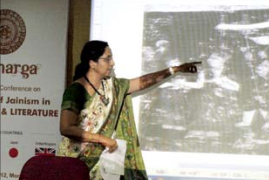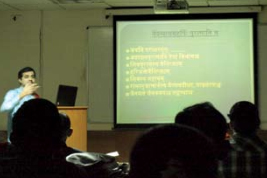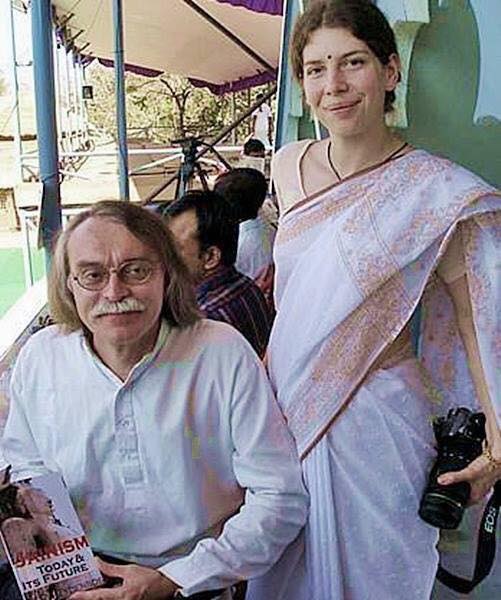
Centre of Jaina Studies Newsletter: SOAS - University of London
On January 2nd, 2012, a one-day conference on Jaina Studies took place in Bengaluru (the city formerly known as Bangalore), at a somewhat unexpected venue. Jain University (previously known as Sri Bhagawan Mahaveer Jain College) is a 'deemed university' according to the Indian University Grants Commission Act, that has focussed on technological and management studies, although it also comprises a Centre for Ancient Indian History & Culture. Sanmarga (the name of this 'international conference on the influence of Jainism in art, culture and literature'[1]) took place in Jain University's Center for Management Studies on Palace Road in Bengaluru. The centre was very well equipped for the event, and organization and hospitality were very good.
Jain University presents itself more like an Americanstyle business school than a traditional European-style university, but representatives of the University told the present reviewer that there is an intention to strengthen its humanities program and, as the name of the University well suggests, to give the study of Jainism a place in that program. Although it was not explicitly stated during the conference, an observer could see the conference as a first public announcement of the University's interest in such a possible structural expansion of its teaching and research program.
One interesting innovation of this conference was that presentations were made in four different languages: English, Kannada, Sanskrit and Hindi. English is of course what one would expect as the conference language of an 'international conference' in India, and it seemed that the English-language presentations drew the largest number of listeners. Karnataka of course has played a role of enormous importance in the overall history of Jainism, because already very early it became the de facto intellectual homeland of Digambara Jainism. Where the 'influence of Jainism' in Indian culture is concerned, the influence of the Digambara variety of Jainism is arguably greater than that of the Śvetāmbara variety. Unfortunately, until now the wealth of historical and intellectual information that lies preserved in literary sources in Kannada has hardly been tapped by scholars and researchers outside Karnataka, although a few generations of modern scholars in Karnataka already have been working on this material, but as a rule presenting the results of their research again in Kannada. It was only appropriate that at this conference, in Bengaluru (in other words: in Karnataka, in the Kannada land), Kannada was one of the conference languages, which enabled Karnatakan researchers to present findings of their work freely. On the whole, the Kannada speakers presented their materials in a way that was accessible also to nonspecialists in the field of Karnatakan Jaina Studies.

Sujatha Shastri, Sholapur, speaking on historical pilgrimages to Śravaṇabeḷagoḷa

K.S. Suman Bengaluru, speaking on references to Jainism in the Liṅgapurāṇa
A reporter cannot possibly do justice to all of the presentations, simply because one could not attend all of them due to overlaps in scheduling. However, a few presentations deserve special notice. The presentation in the Sanskrit-language section that was perhaps the most refreshing and informative was by Dr. K.S. Suman of the Sri Bhagavan Mahavir Degree College, Bengaluru, titled 'Bādarāyaṇaviracite Liṅgapurāṇe jainavaiṣṇavamatayoḥ sāmarasyapratipādakavacanāni'(Utterances teaching the harmony of Jaina and Vaiṣṇava doctrines in the Liṅgapurāṇa of Bādarāyaṇa), which showed that despite all the customary sectarian polemics between representatives of the Jaina and Vaiṣṇava faiths, there have been authors who seriously looked for a common ground on which to base a constructive dialogue. Also refreshing was a presentation in the English-language section by Mrs Sujatha Shastri of Sholapur, titled 'The Pilgrimage Tradition as Reflected in the Inscriptions and Paintings of Shravanabelagola', which focussed on concrete historical information about pilgrimages to this holy site of Digambara Jainism and with a wealth of visual material made a part of the past come alive. Informative in a quite different manner was a talk with illustrations by Ramesh Kumar Shah, Bengaluru, on 'Jain Temples in Pakistan an eye-opener', who on the one hand reported about wanton damage that has been done to the remains of Jaina temples by unruly social elements in recent times (for instance, as a totally misplaced act of revenge in the wake of the 1992 Babri Masjid demolition in Ayodhya), but also about the sincere interest in the Jaina history of Pakistan on the part of Pakistani scholars.
Most of the presentations dealt with historical topics and were presented ably by scholars with experience in these fields of research. There were interesting papers on sculpture (also in Bengal, by Dr. Gourishankar De, Habra, West Bengal), architecture (also one on Jaina architecture in Kerala, by Mrs M.V. Ranjini, Kalady, Kerala), pilgrimage, works of literature, ritual, logic and even one on astrology (by Dr. M. Harinarayanan, Tiruvanantapuram). There was also a presentation about the 'scientifically' proven virtues of vegetarianism. The one thing that was missing from the content of the presentations in this conference as a whole was what Jainism has contributed to art, culture and literature of the world, as a coherent system of thought, apart from the individual beautiful and impressive cultural products of persons who happened to have been Jainas; but here one could argue that those would have been topics of comparative study that might demand more than the allotted usual twenty minutes of a conference presentation.
Altogether, Jain University deserves praise for organizing the small but interesting, high-quality conference, and one hopes that more will come.

Digambara Jaina monks hold peacock-feather brooms (mayūra-picchī) in this 10th-century stone relief in the Candragupta Basti at Candragiri hill in Śravaṇabeḷagoḷa, Karṇāṭaka. Photo: Prem Suman Jain, 2012
Robert Zydenbos is professor of Indology in the LudwigMaximilians-Universität in Munich, Germany, where among other things he teaches Kannada, Sanskrit, and Indian philosophy and religions, with a special emphasis on Jainism. Among his publications on Jainism are The Concept of Divinity in Jainism (Toronto, 1993) and Jainism Today and Its Future (Munich, 2006). His website address is: www.lrz.de/~zydenbos
 Prof. Dr. Robert J. Zydenbos
Prof. Dr. Robert J. Zydenbos